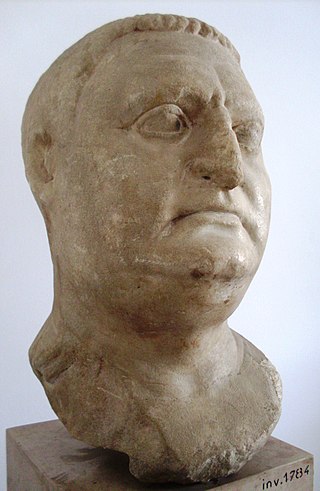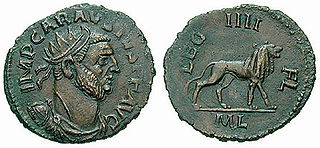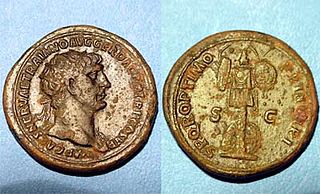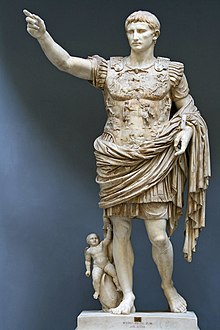
The denarius was the standard Roman silver coin from its introduction in the Second Punic War c. 211 BC to the reign of Gordian III, when it was gradually replaced by the antoninianus. It continued to be minted in very small quantities, likely for ceremonial purposes, until and through the Tetrarchy (293–313).

Marcus Aurelius Antoninus was Roman emperor from 161 to 180 and a Stoic philosopher. He was a member of the Nerva–Antonine dynasty, the last of the rulers later known as the Five Good Emperors and the last emperor of the Pax Romana, an age of relative peace, calm, and stability for the Roman Empire lasting from 27 BC to 180 AD. He served as Roman consul in 140, 145, and 161.

Aulus Vitellius was Roman emperor for eight months, from 19 April to 20 December AD 69. Vitellius was proclaimed emperor following the quick succession of the previous emperors Galba and Otho, in a year of civil war known as the Year of the Four Emperors. Vitellius was the first to add the honorific cognomen Germanicus to his name instead of Caesar upon his accession. Like his predecessor, Otho, Vitellius attempted to rally public support to his cause by honoring and imitating Nero who remained popular in the empire.

Commodus was a Roman emperor who ruled from 177 to 192. For the first three years of his reign he was co-emperor with his father Marcus Aurelius. Commodus' sole rule, starting with the death of Aurelius in 180, is commonly thought to mark the end of a golden age of peace and prosperity in the history of the Roman Empire.

Marcus Aurelius Mausaeus Carausius was a military commander of the Roman Empire in the 3rd century. He was a Menapian from Belgic Gaul, who usurped power in 286, during the Carausian Revolt, declaring himself emperor in Britain and northern Gaul. He did this only 13 years after the Gallic Empire of the Batavian Postumus was ended in 273. He held power for seven years, fashioning the name "Emperor of the North" for himself, before being assassinated by his finance minister Allectus.

Hostilian was briefly Roman emperor in 251. Hostilian was born to Decius and Herennia Etruscilla at an unknown date and elevated to caesar in 250 by Decius. After Decius and Herennius Etruscus, Hostilian's brother, were killed at the Battle of Abritus, an ambush by the Goths, Trebonianus Gallus was proclaimed emperor by the legions. Almost immediately, he elevated Hostilian to co-emperor and his own son, Volusianus, to caesar. Hostilian died soon after, either due to plague or being murdered by Trebonianus Gallus.

The dupondius was a brass coin used during the Roman Republic and Roman Empire valued at 2 asses.

Roman currency for most of Roman history consisted of gold, silver, bronze, orichalcum and copper coinage. From its introduction during the Republic, in the third century BC, through Imperial times, Roman currency saw many changes in form, denomination, and composition. A persistent feature was the inflationary debasement and replacement of coins over the centuries. Notable examples of this followed the reforms of Diocletian. This trend continued with Byzantine currency.

The Roman salute, alternatively called the Fascist salute, is a gesture in which the right arm is fully extended, facing forward, with palm down and fingers touching. In some versions, the arm is raised upward at an angle; in others, it is held out parallel to the ground. In contemporary times, the former is commonly considered a symbol of fascism that had been based on a custom popularly attributed to ancient Rome. However, no Roman text gives this description, and the Roman works of art that display salutational gestures bear little resemblance to the modern Roman salute.

The aureus was a gold coin of ancient Rome originally valued at 25 pure silver denarii. The aureus was regularly issued from the 1st century BC to the beginning of the 4th century AD, when it was replaced by the solidus. The aureus was about the same size as the denarius, but heavier.

The Arch of Septimius Severus at the northwestern end of the Roman Forum is a white marble triumphal arch dedicated in 203 AD to commemorate the Parthian victories of Emperor Septimius Severus and his two sons, Caracalla and Geta, in the two campaigns against the Parthians of 194-195 and 197–199. After the death of Septimius Severus, his sons Caracalla and Geta were initially joint emperors. Caracalla had Geta assassinated in 212; in the practice now known as damnatio memoriae, Geta's memorials were destroyed and all images or mentions of him were removed from public buildings and monuments. Accordingly, Geta's image and inscriptions referring to him were removed from the arch.

The Equestrian Statue of Marcus Aurelius is an ancient Roman equestrian statue on the Capitoline Hill, Rome, Italy. It is made of bronze and stands 4.24 m tall. Although the emperor is mounted, the sculpture otherwise exhibits many similarities to the standing statues of Augustus. The original is on display in the Capitoline Museums, while the sculpture now standing in the open air at the Piazza del Campidoglio is a replica made in 1981 when the original was taken down for restoration.

The Column of Marcus Aurelius is a Roman victory column in Piazza Colonna, Rome, Italy. It is a Doric column featuring a spiral relief: it was built in honour of Roman emperor Marcus Aurelius and modeled on Trajan's Column. The Imperial Monument is dedicated to the former emperor of Rome and his war effort in the Barbarian wars of his reign as Caesar of Rome from 161-180 AD. Though there aren’t many direct sources from the time of reign of Marcus Aurelius, the monument itself can tell us a great deal about the Romans in the creation of the monument and the scenes from it. The column of Marcus Aurelius is a depiction of Roman life during the reign of Marcus Aurelius; the monument not only tells us the reason it was built but the importance this emperor had on society and the respect he had earned. Based on common understanding of Roman life and the belief that citizens felt a duty toward public service, the benevolence of Marcus Aurelius was such that this monument was erected in his memory and preserved for its grandeur and representation. The monument contains a frieze, which depicts the Northern Germanic campaigns of Marcus Aurelius’ and his war with the Barbarians. The Romans called these wars North of the Danube, Bellum Germanicum or bellum Marcomannicum. Though the monument is more likely a monument for military achievement, it’s also considered a funerary monument, since the planning and erection of the monument happened around the same time as the death of Marcus Aurelius. The monument was said to either begin at the end of the wars in 176AD and he died in 180AD, the monument finished construction in 193AD.

The Column of Antoninus Pius is a Roman honorific column in Rome, Italy, devoted in AD 161 to the Roman emperor Antoninus Pius, in the Campus Martius, on the edge of the hill now known as Monte Citorio, and set up by his successors, the co-emperors Marcus Aurelius and Lucius Verus.

Tigranes VI, also known as Tigran VI or by his Roman name Gaius Julius Tigranes was a Herodian prince and served as a Roman client king of Armenia in the 1st century.
The procuratorial coinage of Roman Judaea was minted by the prefects and procurators of the province between AD 6 and 66 in only one denomination and size, the bronze prutah.

The Ludovisi Battle sarcophagus or "Great" Ludovisi sarcophagus is an ancient Roman sarcophagus dating to around AD 250–260, found in 1621 in the Vigna Bernusconi, a tomb near the Porta Tiburtina. It is also known as the Via Tiburtina Sarcophagus, though other sarcophagi have been found there. It is known for its densely populated, anti-classical composition of "writhing and highly emotive" Romans and Goths, and is an example of the battle scenes favored in Roman art during the Crisis of the Third Century. Discovered in 1621 and named for its first modern owner, Ludovico Ludovisi, the sarcophagus is now displayed at the Palazzo Altemps in Rome, part of the National Museum of Rome as of 1901.

Nerva was Roman emperor from 96 to 98. Nerva became emperor when aged almost 66, after a lifetime of imperial service under Nero and the succeeding rulers of the Flavian dynasty. Under Nero, he was a member of the imperial entourage and played a vital part in exposing the Pisonian conspiracy of 65. Later, as a loyalist to the Flavians, he attained consulships in 71 and 90 during the reigns of Vespasian and Domitian, respectively. On 19 September 96, Domitian was assassinated in a palace conspiracy involving members of the Praetorian Guard and several of his freedmen. On the same day, Nerva was declared emperor by the Roman Senate. As the new ruler of the Roman Empire, he vowed to restore liberties which had been curtailed during the autocratic government of Domitian.
The Feriale Duranum is a calendar of religious observances for a Roman military garrison at Dura-Europos on the Euphrates, Roman Syria, under the reign of Severus Alexander.

Fortuna Redux was a form of the goddess Fortuna in the Roman Empire who oversaw a return, as from a long or perilous journey. Her attributes were Fortuna's typical cornucopia, with her specific function represented by a rudder or steering oar sometimes in conjunction with a globe.






















